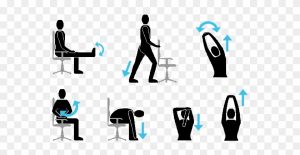Posture refers to the position of your body in space. Good posture involves keeping the body symmetrical while maintaining the natural curvatures of the spine. Bad posture, which often involves slouching and a forward positioning of the head and shoulders, brings the body out of its natural alignment. This increases the risk of developing injuries and pain in muscles and joints.
This article will review good posture in sitting, standing, and with movement; the benefits of good posture; and exercises to improve posture.
Ways to Improve Posture
Improving your posture starts with being aware of what good posture is. Proper posture ensures that your body maintains a state of balance that is able to support optimal movement. Deviating away from good posture causes a state of imbalance, often resulting in musculoskeletal problems.1
Sitting

On average, people spend at least six hours of the day sitting, and this time increases for people who go to school or have sedentary jobs involving desk or computer work. Maintaining good posture while sitting is important for preventing muscles from getting tight and joints from getting stiff when staying in the same position for a long period of time.2
Proper posture in sitting involves keeping the spine and body upright while maintaining the natural lumbar lordosis (the inward curve) of the lower back with the pelvis slightly tilted anteriorly (forward). This position reduces pressure on the spinal discs.2
The head and neck should be upright and aligned over the spine with the shoulders back. The hips and knees should be bent at 90 degrees. The hips and legs should be symmetrical, with equal weight bearing through each side of the body without crossing the legs.
Standing

Standing posture is similar to a sitting posture in which the head and neck should be upright and aligned over the spine with the shoulders back. Because the curve of the lower back is increased in standing, the pelvis should be level, without being tilted anteriorly or posteriorly (backward), to maintain the balance of the body.2
Your shoulders should be aligned over your hips, and your hips should be aligned over your ankles with equal weight bearing through each side of the body without leaning to one side.
Moving

Proper posture with movement involves keeping your joints properly supported and aligned. Your feet and ankles should be maintained in a neutral position without rolling in or out too much. Your knees should be aligned with your hips and ankles without caving in. Your spine should be stabilized so that it is not excessively slouched or arched.
Wearing supportive footwear without a high heel and maintaining a healthy weight can help decrease stress at your joints, which can support good posture with movement.3
Posture Exercises
If you’re wondering how to fix bad posture for lasting results, posture exercises can help. Increased strength in certain muscle groups will help support your joints and alignment of your body to maintain good posture. Stretching other muscle groups can help improve your flexibility, which can decrease tight muscles from keeping you in a state of bad posture. Often, bad posture can be reversed with proper stretching and strengthening exercises.1
Posture correction stretches include:1

- Upper trapezius (upper back muscle) stretch
- Levator scapulae (side of neck muscles) stretch
- Hip flexor (side of hips) stretch
- Lower back stretch
Posture correction exercises include:1
- Chin tucks to strengthen the deep cervical muscles
- Rowing exercises and shoulder blade squeeze to strengthen the middle trapezius
- Bridges, hip thrusts, and prone leg lifts to strengthen the gluteus maximus (butt muscle)
- Core exercises to strengthen the abdominals (stomach muscles)
Certain types of abnormal postures can result from neuromuscular disorders that affect muscle tone or cause muscle weakness, such as cerebral palsy, muscular dystrophy, and strokes. In these cases, it may not be possible to completely achieve good posture, but treatment options like bracing, splints, slings, and surgery, if needed, can be used to help improve posture and body alignment as much as possible.
Video: “Exercises for the Rehabilitation of Posture Disorders”
SET OF EXERCISES №1 TO IMPROVE POSTURE. ROUND BACK (SLOUCHING)
For additional information about exercises for the rehabilitation of Posture disorders you can watch a video demonstrating exercises and rehabilitation recommendations.
The Benefits of Better Posture
Good posture is important for maintaining the overall balance of your bones, joints, and muscles. Over time, prolonged bad posture and slouching can cause significant muscle tightness and joint stiffness. If not corrected, these changes can become long-lasting, and sometimes permanent.4
By improving your posture, you support the natural healthy alignment of your body that allows it to move with ease. The most common postural problems include:
- Upper crossed syndrome: Altered upper body posture and muscle activation patterns characterized by forward head and shoulders and rounding of the thoracic spine with tightness in the upper trapezius, levator scapulae, and pectorals (chest muscles) and weakness of the deep cervical flexors (front neck muscles), middle and lower trapezius (back muscles), and serratus anterior (fan-shaped muscle near the ribcage).5
- Lower crossed syndrome: Altered lower body posture and muscle activation patterns characterized by anterior pelvic tilt and increased lumbar lordosis, tightness in the hip flexors and lower back muscles, and weakness of the abdominals and gluteus maximus.6
These changes can lead to reduced stability of joints, including those of the spine, hips, and shoulders, due to muscle imbalances that result. Poor upper and lower body posture also commonly causes neck and low back pain.2
Better posture can therefore reduce your risk of injuries and joint and muscle problems and improve your overall quality of life and self-esteem.2
Summary
Posture refers to the position of your body in space. Proper posture in sitting, standing, or with movement involves your head and neck aligned over your spine, shoulders, back, and hips balanced with symmetrical weight bearing on both sides of your body.
Poor posture can lead to joint and muscle problems and injuries, but luckily many cases of bad posture can be fixed with certain stretches and posture correction exercises. For severe cases of bad posture, talk with your healthcare provider. Bad posture resulting from neuromuscular disorders may benefit from splinting, bracing, or surgery.
By Kristen Gasnick, PT, DPT
Kristen Gasnick, PT, DPT, is a medical writer and a physical therapist at Holy Name Medical Center in New Jersey.
By Anne Asher, CPT
Anne Asher, ACE-certified personal trainer, health coach, and orthopedic exercise specialist, is a back and neck pain expert.

CHECK OUT THE DEMO VERSION OF OUR SETS OF EXERCISES FOR THE REHABILITATION OF POSTURE DISORDERS ON YOUTUBE
Our website presents the following sets of exercises for the rehabilitation of Posture disorders:
-
SET OF EXERCISES №1 TO IMPROVE POSTURE. ROUND BACK (SLOUCHING)
-
SET OF EXERCISES №2 TO STRENGTHEN THE MUSCLES OF THE BACK, NECK, STABILIZE THE SHOULDER BLADES OF THE UPPER SPINE
-
SET OF EXERCISES №3 TO IMPROVE POSTURE. FLAT BACK
-
SET OF EXERCISES №4 TO IMPROVE POSTURE. SPINE CURVATURE (SCOLIOSIS)
Sources
Verywell Health uses only high-quality sources, including peer-reviewed studies, to support the facts within our articles. Read our editorial process to learn more about how we fact-check and keep our content accurate, reliable, and trustworthy.
- Seidi F, Bayattork M, Minoonejad H, Andersen LL, Page P. Comprehensive corrective exercise program improves alignment, muscle activation and movement pattern of men with upper crossed syndrome: randomized controlled trial. Sci Rep. 2020 Nov 26;10(1):20688. doi: 10.1038/s41598-020-77571-4.
- In TS, Jung JH, Jung KS, Cho HY. Spinal and pelvic alignment of sitting posture associated with smartphone use in adolescents with low back pain. Int J Environ Res Public Health. 2021 Aug 7;18(16):8369. doi:10.3390/ijerph18168369.
- National Library of Medicine. Guide to good posture.
- Carini F, Mazzola M, Fici C, Palmeri S, Messina M, Damiani P, Tomasello G. Posture and posturology, anatomical and physiological profiles: overview and current state of art. Acta Biomed. 2017 Apr 28;88(1):11-16. doi: 10.23750/abm.v88i1.5309
- Bayattork M, Seidi F, Minoonejad H, Andersen LL, Page P. The effectiveness of a comprehensive corrective exercises program and subsequent detraining on alignment, muscle activation, and movement pattern in men with upper crossed syndrome: protocol for a parallel-group randomized controlled trial. Trials. 2020 Mar 12;21(1):255. doi: 10.1186/s13063-020-4159-9.
- Das, Shriya & Sarkar, Bibhuti & Sharma, Rachana & Mondal, Malika & Kumar, Pravin. (2017). Prevalence of lower crossed syndrome in young adults: A cross-sectional study.International Journal of Advance Research. 5. 2217-2228. doi: 10.21474/IJAR01/4662.







